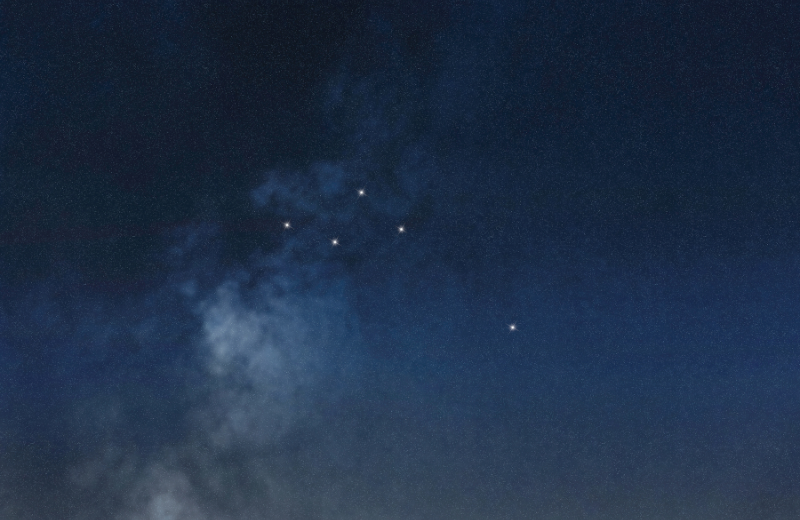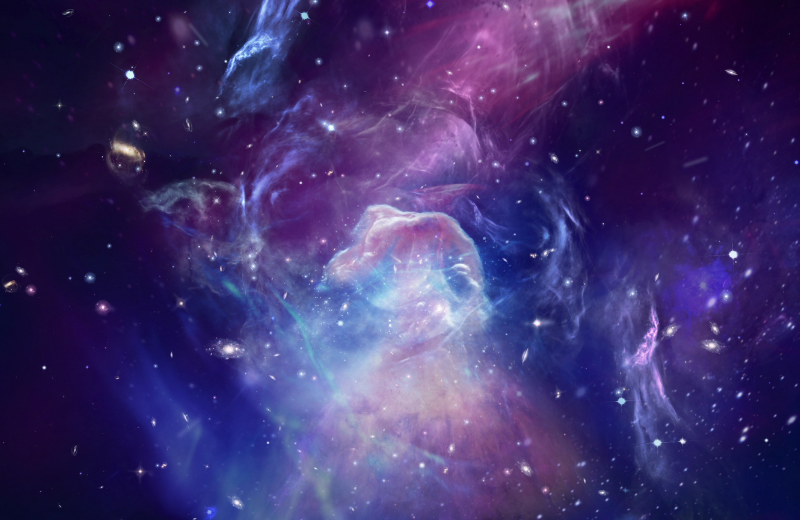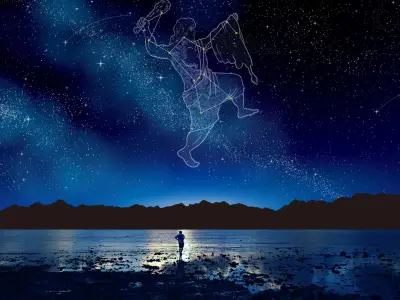Delphinus is a charming little cluster of stars that takes the shape of a dolphin. This guide explores everything you need to know about the Delphinus constellation, from its history to its location in the night sky.
Jump to:
Recommended for you!
Best SellersWhat is the Delphinus Constellation?
Delphinus, also known as the Dolphin Constellation, is a small constellation located in the northern hemisphere. Despite its size, it's a well-known formation due to its distinctive shape and the stories that accompany it. The constellation has been recognised since ancient times, and its stars form a pattern that closely resembles a dolphin leaping through the waves. Delphinus might not be as large or bright as some other constellations, but its charm lies in its compact and neat design.
What Does Delphinus Look Like?

The Delphinus constellation is relatively small and consists of five main stars that form a kite-like or diamond shape, with a short tail that gives the appearance of a dolphin leaping through the sky. While it may not have the bright, prominent stars seen in other constellations, its unique shape makes it easy to spot once you know what to look for.
The stars that make up Delphinus are not particularly bright, with none being brighter than magnitude 3.8. However, their arrangement is quite striking. The key stars are Sualocin and Rotanev, both of which have fascinating origins as they are thought to be names of astronomers spelt backwards.
How Far is the Delphinus Constellation from Earth?
The stars in Delphinus are located at varying distances from Earth. For example, Sualocin is about 241 light years away, while Rotanev is roughly 98 light years away. These stars, though seemingly close together when viewed from Earth, are actually separated by vast distances. When you look at Delphinus, you're seeing light that has travelled for centuries to reach your eyes.
The Delphinus Constellation Myth

In Greek mythology, Delphinus represents the dolphin that helped the Greek poet and musician Arion. Legend has it that Arion, after performing for the king of Corinth, was thrown overboard by greedy sailors who wanted his earnings. He was saved by a dolphin that carried him to safety, thus earning a permanent place in the stars. This myth is just one of many stories that tie constellations to ancient legends, making Delphinus a symbol of rescue and loyalty.
Delphinus's Stars
While Delphinus may not contain any of the brightest stars in the sky, it does have some notable ones:
- Sualocin (Alpha Delphini): This is the brightest star in the constellation, a binary star system approximately 241 light years away from Earth. Its name, when read backwards, spells “Nicolaus,” a tribute to the astronomer Nicolaus Venator.
- Rotanev (Beta Delphini): The second brightest star in the constellation, Rotanev, is about 98 light years away. Like Sualocin, its name is also a playful reversal, this time of “Venator,” the Latin name for the astronomer responsible for naming it.
- Gamma Delphini: A beautiful binary star system, Gamma Delphini is often observed by amateur astronomers because of the contrasting colours of the two stars—one yellow and the other pale green.
Nebulae in the Delphinus Constellation

Delphinus may be small, but it has some interesting deep-sky objects, though not as many as larger constellations. Among these are several faint galaxies and planetary nebulae. The most notable of these deep-sky objects is NGC 6891, a planetary nebula, which is a cloud of ionised gas surrounding a dying star. Though it’s not visible to the naked eye, with a good telescope, you can catch a glimpse of this fascinating nebula.
Finding Delphinus in the Sky
Delphinus is best observed during the late summer and early autumn months, particularly in August and September in the northern hemisphere. During this time, the constellation is higher in the sky, making it easier to spot and enjoy.
Locating Delphinus
To find Delphinus, start by locating the Summer Triangle, a prominent feature of the summer sky in the northern hemisphere. This triangle is formed by the stars Altair, Vega, and Deneb. Delphinus is located just to the east of the Summer Triangle, near Altair in the constellation Aquila. While the stars in Delphinus aren’t very bright, its distinctive dolphin-like shape is easy to recognise once you know where to look.
Delphinus is visible from both the northern and southern hemispheres, though in the southern hemisphere, it will appear in an upside-down orientation compared to the northern view.
Viewing Delphinus with Binoculars or a Telescope
With binoculars, the stars of Delphinus will become more distinct, allowing you to appreciate the delicate shape of the dolphin. Sualocin and Rotanev, the two brightest stars in the constellation, can be easily identified. A telescope can reveal even more detail, including some faint deep-sky objects, like planetary nebulae.
Best Viewing Conditions
For the best stargazing experience, head to a location with minimal light pollution on a clear, moonless night. Once you’ve found the Summer Triangle, shift your gaze slightly to locate Delphinus, and enjoy watching this graceful dolphin leap through the night sky.
Recommended for you!
Best SellersFun Facts About Delphinus
- Nickname: Delphinus is often called the “Dolphin Constellation” because of its shape and the mythological stories tied to it.
- Size: While not the smallest constellation, Delphinus is relatively small. It covers an area of just 189 square degrees, making it the 69th largest constellation out of the 88 recognised ones.
- Double Stars: One of the most fascinating features of Delphinus is its double stars, particularly Gamma Delphini, which is a popular target for amateur astronomers.
- Star Names: The main stars in Delphinus, Sualocin and Rotanev, have a fun history behind their names, which are the reversed forms of an astronomer’s name, Nicolaus Venator.
Study Astronomy for £29
If the Delphinus constellation has sparked your curiosity, why not explore more about the stars and the cosmos with our Astronomy Diploma Course at Centre of Excellence? This course offers a detailed understanding of the universe, from constellations and star types to the fundamentals of space observation. Perfect for all budding astronomers, the course is available for a discounted price of £29.













